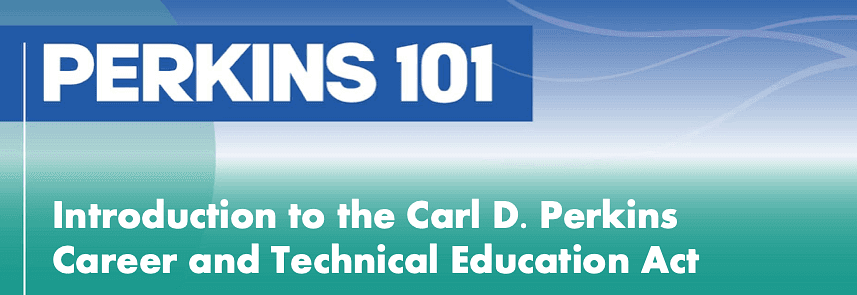ACTE has released a set of briefs that describe the components of Perkins V legislation in an easy-to-understand manner. These short publications can serve as an introduction for teachers, administrators, policymakers, journalists, partners and others who are new to the purpose, importance and impact of this federal law.
- Perkins 101: Introduction to the Carl D. Perkins Career and Technical Education Act (February 2025)
- Perkins 101: Federal Funding (February 2025)
- Perkins 101: Accountability (February 2025)
- Perkins 101: Comprehensive Local Needs Assessment (February 2025)
Utah conducts annual Perkins trainings. These are the slides from the most recent event. (March 2025)
Below is a highlight from the first in the set of ACTE briefs.


The Carl D. Perkins Career and Technical Education Act (Perkins Act) is the primary piece of legislation that supports career and technical education (CTE) on the federal level.
The Perkins Act is not the same as Perkins loans, which was a federal student loan program that ended in 2017. However, both were named for Rep. Carl D. Perkins (D-KY), who served in Congress from 1949-1984 and advocated for many education priorities.
History of the Perkins Act
CTE has been significantly funded on the federal level since the Smith-Hughes Vocational Education Act of 1917. This legislation was followed by several other CTE-related laws, notably the Vocational Education Act (VEA) of 1963, which is the precursor to our current Perkins Act. The VEA has been amended multiple times, the last time in 2018. The name of the current law is the Carl D. Perkins Career and Technical Education Act of 2006, as amended in 2018 by the Strengthening Career and Technical Education for the 21st Century Act. It is informally known as Perkins V.
Perkins V allocates funding to states to “develop more fully the academic knowledge and technical and employability skills of secondary education students and postsecondary education students who elect to enroll in career and technical education programs and programs of study.”
Importance of the Perkins Act
As the primary federal support for CTE, the Perkins Act provides a significant amount of funding for CTE programs in many states. Even in states that have robust state funding for CTE, it may be the only funding stream that is dedicated to CTE innovation and improvement – to developing new programs and improving existing programs, not to funding basic operational costs like everyday consumable supplies or school building maintenance.
In addition to its importance as a source of funding, the law is significant because it requires accountability for student performance outcomes; incentivizes increased alignment across CTE and core academics, across education and the labor market, and across the secondary, postsecondary and workforce systems; and encourages expanded access to high-quality CTE programs. The policies that states adopt under Perkins often drive state and local funding investments in CTE.
Key Components of the Law
Funding
Perkins V has three funding streams: the Basic State Grant, National Activities and Tribally Controlled Postsecondary Career and Technical Institutions.
The Basic State Grant is the largest funding stream within the Perkins Act and was funded at $1.44 billion in Fiscal Year (FY) 2024. Funding is allocated to each state by a formula based on population aged 15-65 and per-capita income. Within each state allocation, a state may hold up to 15% for state administrative costs, required set-asides that promote access to CTE for specific learner groups, and other leadership activities. The remaining at least 85% is allocated to local recipients, which are primarily school districts and postsecondary institutions.
Funding under National Activities supports research and evaluation of CTE, while the third funding stream directs money to postsecondary career and technical institutions that are controlled by Tribes or Tribal organizations.
State Plans and Local Applications
To receive funding, states must have originally submitted a four-year state plan in FY 2020, describing how they would use federal funds as well as setting performance targets for accountability indicators. After four years, states could extend their current plan or submit a new plan. Therefore, many states submitted new plans or amended their plans for FY 2024. State plans must be developed or amended with the input of a variety of stakeholders, including the Governor, other state agencies, education and workforce representatives, industry partners, students, families and more.
On the local level, each recipient of funding must have submitted to the state a local application, and local recipients must submit updates or new applications as required by that state. The local application describes how the recipient will use funds to respond to needs identified by their comprehensive local needs assessment, which is described in the next section.
Comprehensive Local Needs Assessment
A new requirement under Perkins V, each local recipient of funding must have completed a comprehensive local needs assessment (CLNA) of their CTE programs at the beginning of Perkins V. Following the initial CLNA, the needs assessment must be updated at least every two years. The CLNA must consider:
- Student performance on Perkins V accountability indicators, disaggregated by a number of learner groups
- Alignment of programs to labor market needs
- Whether programs are of sufficient size, scope and quality to meet all students’ needs
- Progress toward implementing programs and programs of study
- Efforts to improve recruitment, retention and training of faculty and staff
- Progress toward improving access and equity
Unlike the generic term "program," the term "program of study" is defined in Perkins V as a coordinated, nonduplicative sequence of academic and technical content at the secondary and postsecondary level that incorporates academic, technical and employability knowledge, skills and standards; aligns with industry needs; progresses in specificity from broader to more occupationally specific; has multiple entry and exit points that incorporate credentialing; and culminates in the attainment of a recognized postsecondary credential. Each local recipient must offer at least one program of study.
Accountability
States and local recipients are required to report annually on the number of CTE participants (students who take one CTE course) and CTE concentrators (students who take multiple courses or credits in one CTE program area). In addition, states and local recipients must report annually on the following performance measures for CTE concentrators only.
| Secondary Indicators of Performance | Postsecondary Indicators of Performance |
|---|---|
|
|
This data must be disaggregated by gender, race/ethnicity, migrant status (on the secondary level only) and the Perkins V special populations, which are defined below, as well as by Career Cluster®. However, states and local recipients are only held accountable for overall CTE concentrator performance for each indicator.
Special Populations
Perkins V defines the following learner groups as special populations:
- Individuals with disabilities
- Individuals from economically disadvantaged families, including low-income youth and adults
- Individuals preparing for careers that are non-traditional for their gender
- Single parents, including single pregnant women
- Out-of-workforce individuals
- English learners
- Homeless individuals
- Youth who are in, or have aged out of, the foster care system
- Youth with a parent who is a member of the armed forces and is on active duty
States and local recipients must report disaggregated data for these learner groups, as noted above.
There are additional provisions in the law about providing funding and services to special populations. This includes required uses of funding on the state level for recruiting special populations into CTE and for preparing students for careers non-traditional for their gender, as well as permissible uses of state and local funding for providing supports for these populations.
Learn more
To learn more about the topics addressed in this brief, consult the following resources:
- Perkins 101: Federal Funding (ACTE, 2025)
- Perkins 101: Accountability (ACTE, 2025)
- Perkins 101: Comprehensive Local Needs Assessment (ACTE, 2025)
- Perkins V: The Official Guide to the Strengthening Career and Technical Education for the 21st Century Act (ACTE, 2018)
- A Brief History of CTE (ACTE, 2021)
- CTE Policy Past, Present, and Future: Driving Forces Behind the Evolution of Federal Priorities (Imperatore & Hyslop, 2017)



















